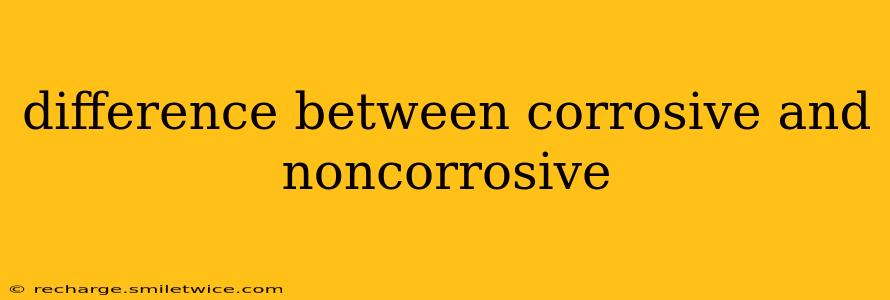Understanding the difference between corrosive and non-corrosive substances is vital for safety, particularly in industrial settings and everyday life. While both terms relate to materials' interactions with other substances, their effects are vastly different. This article will delve into the core distinctions, exploring the mechanisms of corrosion and offering practical examples.
What is Corrosion?
Corrosion is the gradual destruction of materials (usually metals) by chemical or electrochemical reactions with their environment. This process often involves the oxidation of the material, leading to its deterioration and weakening. Think of rust on a car – that's a classic example of corrosion.
What Makes a Substance Corrosive?
A corrosive substance is one that will cause visible destruction or irreversible damage to living tissue or other materials on contact. This damage typically involves a chemical reaction that breaks down the material's structure. The degree of corrosiveness can vary greatly depending on the substance's chemical properties, concentration, and contact time.
Key Characteristics of Corrosive Substances:
- Chemical Reactivity: Corrosive substances are highly reactive, readily entering into chemical reactions with other materials.
- Damage to Tissue: Contact with corrosive substances can cause burns, ulcers, and other tissue damage. The severity depends on factors like concentration and duration of exposure.
- Material Degradation: Corrosive substances can degrade various materials, including metals, plastics, and even some ceramics.
What Makes a Substance Non-Corrosive?
A non-corrosive substance is one that does not cause significant damage to living tissue or other materials upon contact. It may react with certain substances, but the reaction is generally slow, minimal, or doesn't lead to substantial degradation.
Key Characteristics of Non-Corrosive Substances:
- Low Reactivity: Non-corrosive substances have a low chemical reactivity, meaning they don't readily react with other materials.
- Minimal Tissue Damage: Contact with these substances generally does not cause significant harm to living tissue.
- Material Stability: They typically do not cause substantial degradation of common materials.
Examples of Corrosive and Non-Corrosive Substances
Corrosive Substances:
- Acids (e.g., sulfuric acid, hydrochloric acid): These react vigorously with many metals and cause severe burns to skin and eyes.
- Bases (e.g., sodium hydroxide, potassium hydroxide): These are also highly reactive and can cause severe chemical burns.
- Oxidizing agents (e.g., hydrogen peroxide, nitric acid): These substances readily accept electrons, causing oxidation and often leading to rapid degradation of materials.
Non-Corrosive Substances:
- Water (pure): While water can participate in chemical reactions, it's generally not considered corrosive in its pure form.
- Many alcohols (e.g., ethanol, isopropyl alcohol): These are relatively inert compared to acids and bases.
- Sodium chloride (table salt): At typical concentrations, salt is non-corrosive, although high concentrations can contribute to corrosion in certain situations.
Frequently Asked Questions
What are the safety precautions for handling corrosive substances?
Always wear appropriate personal protective equipment (PPE), including gloves, eye protection, and lab coats. Work in a well-ventilated area, and ensure you have access to emergency eyewash stations and safety showers. Follow all relevant safety data sheets (SDS) meticulously.
How can I tell if a substance is corrosive?
Check the substance's safety data sheet (SDS). The SDS will clearly indicate if a substance is corrosive and provide hazard warnings. Never assume a substance is non-corrosive without proper identification and safety information.
What are the long-term effects of exposure to corrosive substances?
Long-term exposure to corrosive substances can lead to a range of health problems, including scarring, respiratory issues, and organ damage. The severity depends on the substance, the duration of exposure, and the area of contact.
Are all chemicals corrosive?
No, definitely not. Many chemicals are relatively inert and do not pose a corrosive hazard. However, it's crucial to always handle chemicals with care and consult safety data sheets before use.
Understanding the difference between corrosive and non-corrosive substances is a critical aspect of safety and responsible handling of chemicals and materials. By following safety protocols and being aware of the properties of the substances you work with, you can significantly reduce the risk of accidents and injury.
